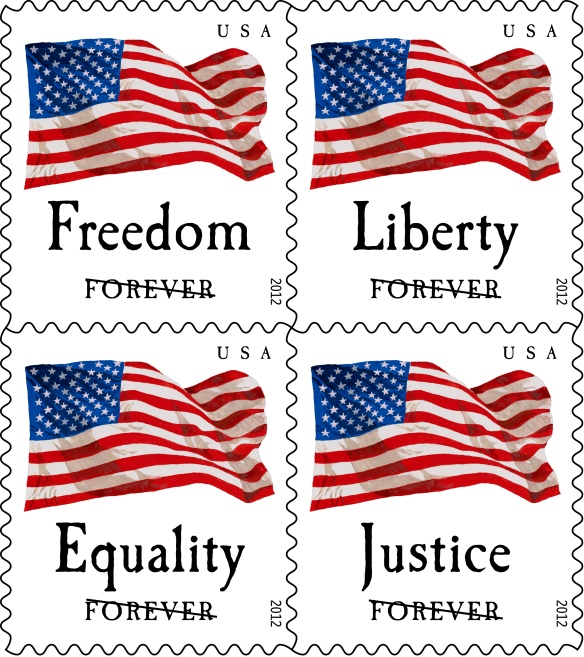Beginning today, the popular Four Flags stamps are available as ATM booklets of 18 stamps. Each of the stamps in this quartet—which was first issued February 22, 2012—features a bright U.S. flag against a white background, accompanied by a single word: Freedom, Liberty, Equality, and Justice.
 The black typeface recalls the look of Colonial-era printing and emphasizes the meaning these four terms held for the colonists who fought the American Revolution. Patriots and Founding Fathers often invoked these words as they struggled to envision a new, democratic nation and make their ideals for the new country a reality.
The black typeface recalls the look of Colonial-era printing and emphasizes the meaning these four terms held for the colonists who fought the American Revolution. Patriots and Founding Fathers often invoked these words as they struggled to envision a new, democratic nation and make their ideals for the new country a reality.
- Liberty: “Give me liberty or give me death.” – Patrick Henry, 1775
- Equality: “We hold these truths to be self-evident, that all men are created equal…” – Thomas Jefferson, Declaration of Independence, 1776
- Freedom: “Posterity! You will never know how much it cost the present generation to preserve your freedom. I hope you will make good use of it.” – John Adams, 1777
- Justice: “We the People of the United States, in Order to form a more perfect Union, establish Justice, insure domestic Tranquility, provide for the common defence, promote the general Welfare, and secure the Blessings of Liberty to ourselves and our Posterity, do ordain and establish this Constitution for the United States of America.” – Constitution of the United States, 1787
Each envelope in this set features a different Four Flags (Forever®) stamp and an official First Day of Issue postmark (click for more information).
The current U.S. flag, which is depicted on these stamps, consists of 13 stripes and 50 stars. Congress passed legislation in 1818 stating that the number of stars on the flag should match the number of states in the Union. It also specified that new stars would be added to the flag on the first July 4th after a state’s admission. The current flag’s 50th star was added on July 4, 1960, after Hawai‘i became a state on August 21, 1959. The flag’s 13 stripes represent the 13 original states.
The Four Flags stamps are being issued as Forever® stamps. (Forever stamps are always equal in value to the current First-Class Mail one-ounce rate.)
If you wish to obtain the first-day-of-issue postmark by mail, purchase the new stamps and affix them to envelopes of your choice. Address the envelopes to yourself or others, and place them in larger envelopes addressed to:
Four Flags
Postmaster
1202 E First Street
Humble, TX 77338-9998
After applying the first-day-of-issue postmark, the Postal Service will return the envelopes through the mail. There is no charge for the postmark.



